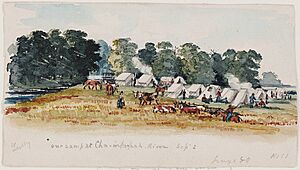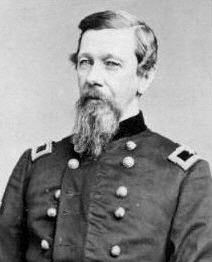Alfred Sully facts for kids
Alfred Sully (May 22, 1820 – April 27, 1879) was an important military officer in the United States Army. He served during the American Civil War and in conflicts with Native American tribes, often called the Indian Wars, on the American frontier. Besides his military career, Sully was also a talented painter.
About Alfred Sully

Alfred Sully was the son of Thomas Sully, a famous portrait painter from Pennsylvania. Alfred followed a different path, graduating from the West Point military academy in 1841.
After his training, Sully served in many parts of the country. During and after the American Civil War, he was active in the Great Plains region. He became known for his role in battles against Native American tribes. Like his father, Alfred Sully was also an artist. He enjoyed painting with watercolors and oils. From 1849 to 1853, he was the chief quartermaster (a military officer in charge of supplies) for U.S. troops in Monterey, California. During this time, he created many paintings that showed what life was like in Monterey.
Military Service
Sully's military career included several important commands. In June 1861, at the start of the Civil War, he led U.S. troops from Fort Leavenworth, Kansas. He took control of St. Joseph, Missouri, and declared martial law (military rule). This happened because there were violent uprisings in the city by people who wanted to leave the Union.
On February 3, 1862, Sully became a colonel and led the 1st Minnesota Volunteer Infantry regiment. He fought with his regiment in the Peninsula Campaign in Virginia. He was slightly wounded in the Battle of Glendale. Sully was promoted to brigadier general on September 26, 1862. He then led a brigade (a large group of soldiers) in the Battle of Chancellorsville. However, he was later removed from this command.
After being removed from his Civil War command, Sully was sent to the Great Plains. There, he led troops in conflicts against Native American tribes. One notable event was the Battle of Whitestone Hill in Dakota Territory on September 3, 1863. His troops fought against a large village of Yankton, Dakota, Hunkpapa, and Sihasapa Lakota people.
When the Civil War ended, Sully's rank as brigadier general expired. He returned to his permanent rank of major in the regular army. Even though he often had health problems, he continued to serve in the Indian Wars. He passed away at Fort Vancouver, Oregon, on April 27, 1879. He was buried in Laurel Hill Cemetery in Philadelphia.
Family Life
Alfred Sully was married three times during his life.
After the Mexican War, in 1851, he was stationed in Monterey, California. There, he married María Manuela Antonia Jimeno y de la Guerra. Sadly, Manuela died in 1852 shortly after giving birth to their son, Thomas. Their son also passed away 18 days later.
From 1856 to 1857, Sully was posted at Fort Pierre in what is now South Dakota. He met and married a young French-Yankton woman from the Yankton Sioux tribe, following their tribal customs. Through this marriage, Sully became the son-in-law of Saswe, also known as François Deloria. Saswe was a powerful Yankton medicine man and tribal chief.
In 1869, Sully married Sophia Henrietta Palmer in Manhattan, New York.
Notable Descendants
Sully had a daughter with his Yankton Sioux wife named Mary Sully. She was known as Akicita Win (Soldier Woman). Mary married Rev. Philip Joseph Deloria, an Episcopal priest who was also known as Tipi Sapa (Black Lodge). Tipi Sapa was a leader of the Yankton/Nakota band of the Sioux Nation. He is honored at the National Cathedral in Washington, D.C., as the first Dakota Christian minister to his own people.
Among their descendants are several important figures. One is Ella Deloria, a Yankton Sioux ethnologist (someone who studies cultures). Another is her nephew, Vine Deloria, Jr., a well-known scholar and writer. He wrote the famous book Custer Died for Your Sins.
Images for kids




